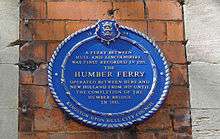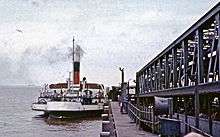Humber Ferry
The Humber Ferry was a ferry service on the Humber between Kingston upon Hull and New Holland in Lincolnshire which operated until the completion of the Humber Bridge in 1981.
 | |
| Locale | England |
|---|---|
| Waterway | Humber |
| Began operation | 1315 |
| Ended operation | 24 June 1981 |
History
The Norse-derived names of North Ferriby and South Ferriby suggest a ferry between them across the Humber Gap.
The first record of a ferry across the Humber dates from 1315 when the Warden and Burgesses of Hull were granted a charter by King Edward II to run a ferry between Hull and Barton in Lincolnshire.[1] Pedestrians were halfpenny each, horses one penny and a cart with two horses twopence.
The Corporation of Hull purchased the leases for £3,000 in 1796 (£266,020 in 2015)[2] and both were relet in 1815.
In 1826 a new service started by the New Holland Proprietors between Hull and New Holland. In 1832 they launched a paddle steamer called Magna Charta.[3] In his Picturesque Tour to Thornton Monastery, John Greenwood writing in 1835 records that the steam packet leaves Hull at seven, a quarter past eleven and four o’clock, and leaves New Holland at nine, two and seven o’clock in the evening.[4]
In 1845 the Great Grimsby and Sheffield Junction Railway bought out the ferry services for £10,000 (£892,207 in 2015).[2] The Barton upon Humber service was withdrawn in 1851.
The railway company built a new pier at New Holland some 1,500 feet (460 m) in length with the railway station, allowing direct connection with the ferry service. New Holland Pier railway station opened on 1 March 1848.[5]
The management transferred to the British Transport Commission in 1948 and on 1 January 1959 management of transferred to Associated Humber Lines.
The Hull to New Holland ferry service finished on 24 June 1981 with the opening of the Humber Bridge.[6]
Ships
The vessels operated by the Humber Ferry service – all paddle steamers to cope with the shallow shifting sands of the Humber – were:
| Ship | Launched | Tonnage (GRT) |
Notes and references |
|---|---|---|---|
| PS Magna Charta | 1832 | Two ships have been named the Magna Charta. The first was launched in 1832 and disposed of in 1873[7] and the second ordered in 1873 and in use until 1920[8] | |
| PS Falcon | unknown | Converted to a goods boat in 1849.[7] | |
| PS Prince of Wales | 1842 | 81 | Built by Ditchburn and Mare in 1842. Purchased from the Greenwich Steam Packet Company in 1848. Sold in 1855.[7] |
| PS Queen | 1842 | 78 | Built by Ditchburn and Mare in 1842. Purchased from the Greenwich Steam Packet Company in 1848. Sold in 1857.[7] |
| PS Manchester | 1849 | 291 | Built in 1849 by Robinson and Russell, Milwall. Entered service in 1849. Superseded by another ship of the same name in 1855. Renamed Old Manchester in 1855. Sailed between Garston and Liverpool in 1858-1859. Sold 1864.[7] |
| PS Sheffield | 1849 | 244 | Built in 1849 by H.E Smith, Gainsborough. Entered service in 1849. Superseded by another ship of the same name in 1855. Renamed Old Sheffield in 1855. Sold 1863.[7] |
| PS Manchester | unknown | 174 | Former Clyde Steamer. Purchased in August 1854. Entered service in 1855 on the Humber Ferry. Scrapped in 1874.[7] |
| PS Sheffield | 1855 | 149 | Built by Martin Samuelson and Company in 1855.[9] Entered service in 1855 on the Humber Ferry. Laid up in 1864. Sold in 1865.[7] |
| PS Royal Albion | 1855 | Built in 1855 as a tug, occasionally used on ferry services. Out of service by 1888.[7] | |
| PS Liverpool | 1855 | 220 | Built in 1855 by M. Samuelson and Company, Hull. Passed to the Great Central Railway. Sold for scrap in 1905.[7] |
| PS Doncaster | 1856 | 216 | Built in 1856 by M. Samuelson and Company, Hull. Passed to the Great Central Railway. Sold for scrap in 1913.[7] |
| PS Magna Charta | 1873 | 116 | Built as a relief steamer. Passed to the Great Central Railway in 1897 and the LNER in 1923. Scrapped in 1924.[7] |
| PS Manchester | 1876 | 221 | Built in 1876 by the Goole Engineering and Shipbuilding Company. Passed to the Great Central Railway. Scrapped in 1914.[7] |
| PS Grimsby | 1888 | 351 | Built in 1888 by Earle's Shipbuilding in Hull. Passed to the Great Central Railway. Scrapped in 1923.[7] |
| PS Cleethorpes | 1903 | 302 | Built by Gourlay Brothers of Dundee. Sold around 1934 to the Redcliffe Shipping Company and renamed Cruising Queen. Scrapped shortly afterwards.[7] |
| PS Brocklesby | 1912 | 508 | Built by Earle's Shipbuilding in Hull. Sold in 1935 to the Redcliffe Shipping Company and renamed Highland Queen. Scrapped in 1936.[7] |
| PS Killingholme | 1912 | 508 | Built by Earle's Shipbuilding in Hull. Withdrawn in 1934.[7] |
| PS Tattershall Castle | 1934 | 556 | Built by William Gray & Company in Hartlepool. Withdrawn in 1974. |
| PS Wingfield Castle | 1934 | 550 | Built by William Gray & Company in Hartlepool. Withdrawn in 1974. |
| PS Lincoln Castle | 1941 | 598 | Built by A. & J. Inglis in Glasgow. Withdrawn in 1978. |
References
- "Bridge farewell for Humber ferry boats". Yorkshire Post. England. 21 October 2014. Retrieved 11 November 2015 – via Yorkshire Post website.
- UK Retail Price Index inflation figures are based on data from Clark, Gregory (2017). "The Annual RPI and Average Earnings for Britain, 1209 to Present (New Series)". MeasuringWorth. Retrieved 2 February 2020.
- "New Holland Ferry". Stamford Mercury. England. 14 September 1832. Retrieved 11 November 2015 – via British Newspaper Archive.
- Greenwood, John (1853). A picturesque tour to Thornton monastery. p. 43.
- "New Holland Pier". Subterranean Britannia. Retrieved 11 November 2012.
- Kirk Martin (30 October 2014). Ferries Across the Humber: The Story of the Humber Ferries and the Last Coal Burning Paddle Steamers in Regular Service in Britain. Pen and Sword Transport. ISBN 978-1-5267-6948-0.
- Duckworth, Christian Leslie Dyce; Langmuir, Graham Easton (1968). Railway and other Steamers. Prescot, Lancashire: T. Stephenson and Sons.
- "Crossing the River Humber by Ferry and Other Means". inbarton.atwebpages.com. Retrieved 21 August 2017.
- "The Directors of the Manchester, Sheffield and Lincolnshire Railway...". Hull Packet. England. 29 June 1855. Retrieved 11 November 2015 – via British Newspaper Archive.
